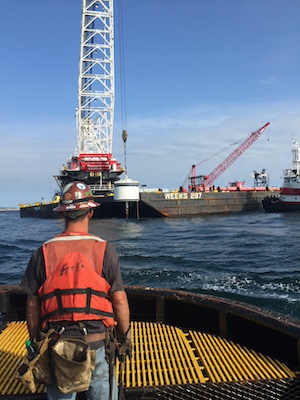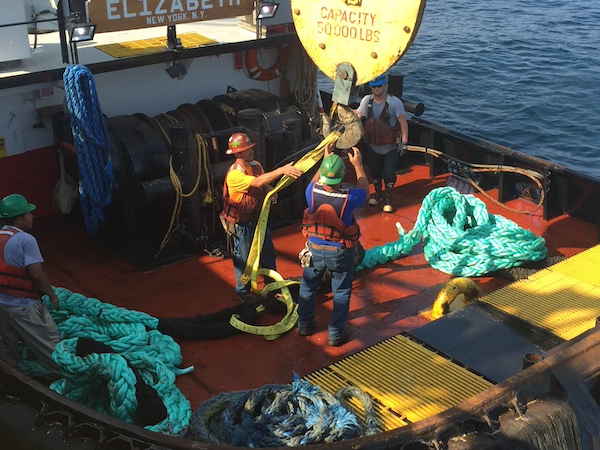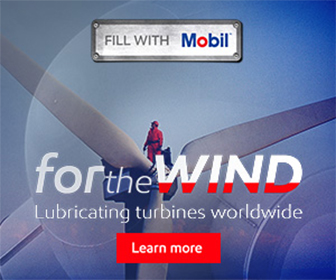Securing a Workforce for America's Offshore Wind Future
 America’s seas are changing. Our first commercial-scale projects now stand with turbines towering over the water, providing electricity to communities and tens of thousands of homes across the East Coast. This burgeoning industry promises a cleaner future, reduced reliance on fossil fuels, and a surge in domestic energy production. However, unlocking its potential hinges on developing a skilled workforce ready to design, build, and maintain these massive wind farms.
America’s seas are changing. Our first commercial-scale projects now stand with turbines towering over the water, providing electricity to communities and tens of thousands of homes across the East Coast. This burgeoning industry promises a cleaner future, reduced reliance on fossil fuels, and a surge in domestic energy production. However, unlocking its potential hinges on developing a skilled workforce ready to design, build, and maintain these massive wind farms.
Federal researchers estimate that anywhere from 15,000 to 58,000 full time workers would be required each year to ramp up worker supply. Many of these jobs are highly skilled or require specialized training, creating uncertainty regarding whether we will hit the target. Our ability to address these challenges and build a workforce for the offshore wind industry will determine not only our ability to meet our goals, but also how much benefit our local communities see from the proliferation of renewable energy.
The good news is the U.S. already has a thriving existing workforce quickly gaining experience as the first projects move through construction into operation and maintenance. There are marshalling ports with electrical workers and fabricators completing components, dockworkers and harbor personnel moving components, production workers manufacturing, assembling, and welding critical components for towers and transition pieces, and vessel operators moving components and people offshore to installation sites. Already, with just two projects under construction, thousands of workers are building offshore wind farms or actively participating in the supporting supply chain. And the federal government has approved five more projects, with dozens more in the queue.
Just a glance tells a story. At the Port of Providence, 160 people assembled advanced foundation components for South Fork Wind and the soon to begin Revolution Wind Project. In Western New York, a manufacturing facility added 100 workers to manufacture and assemble components for anode cages and other secondary structural steel components. And over 100 onshore workers performed the onshore electrical work to connect South Fork Wind to the electrical grid.
Workers with experience in the U.S. are even being tapped to meet global workforce demand. In fact, two-dozen U.S. pile drivers spent the winter working on a project in Europe. With the industry anticipated to need tens of thousands of workers in the next decade in the U.S. alone, global demand is rising simultaneously. This gives workers just getting started a big advantage, because they have the added potential to find work both domestically and abroad.

Despite these gains, however, there are still significant gaps to address, including a lack of understanding that the opportunity exists. Many potential workers remain unaware of the breadth and variety of well-paying careers available in offshore wind. This lack of education about the industry, along with the substantial training needed, translates into a shortage of skilled labor, which threatens to halt wind’s momentum.
The seeds of a future workforce must be sown early. Introducing offshore wind into curriculums, particularly in coastal communities, can spark interest in young students. Interactive programs and field trips to operational wind farms can cement the industry in the minds of our youth, fostering a generation excited about clean energy careers. In a bid to meet this need, Rhode Island recently established the Nation’s first Offshore Wind Energy High School Certification program in 2018.
However, the challenges we face extend beyond mere awareness — we need to scale to meet demand in an efficient and predictable manner. Existing workforce education and training programs should be adapted to incorporate offshore-specific knowledge. Courses in wind turbine technology, marine operations, and specialized safety protocols can equip prospective workers with the foundational knowledge necessary to enter the industry. Government funding can also play a critical role in supporting the development of a skilled and diverse offshore wind workforce. Grants can be allocated to create specialized training programs, expand apprenticeship opportunities, and promote diversity and inclusion initiatives within the industry.

Promoting diversity, equity, inclusion, and accessibility (DEIA) within the offshore wind workforce is essential for long-term success. Companies and workforce development organizations should connect with communities that have been left out of past energy projects, and work with them to develop inclusive training programs. Funding can support programs that encourage women, minorities, veterans, and individuals with disabilities to pursue careers in offshore wind. A diverse workforce brings a wider range of perspectives and experiences to the table, helping to foster innovation and problem-solving.
For experienced workers in related fields, transitioning to the offshore wind industry can offer a new and exciting career path. Developing specialized transition programs can bridge the skill gap, allowing experienced workers from sectors like oil and gas, or even traditional wind energy, to smoothly transition into offshore wind careers.
As is the case in the broader offshore wind industry, collaboration across organizations will be critical to building a strong offshore wind workforce, particularly between industry leaders and educational institutions. By fostering ongoing dialogue, training programs can be tailored to meet the specific needs of the industry, and ensure graduates possess the necessary skills to hit the ground running upon entering the workforce.
Addressing the current knowledge gap and fostering a diverse and skilled workforce can unlock the true potential of offshore wind energy, and propel the nation towards a cleaner, more secure energy future powered by Americans working quality jobs.
Ross Gould is Vice President of Supply Chain Development and Research at Oceantic Network, a member-based organization dedicated to growing the offshore wind and other ocean renewable industries and their supply chains.
Oceantic Network | oceantic.org
Author: Ross Gould
Volume: 2024 May/June












